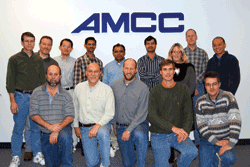Everyone would probably agree that 10-Gbit Ethernet is important and becoming way more so. The Pemaquid S19528 Framer/Mapper/PHY IC breaks new ground in this area. AMCC has been making high-speed SerDes and forward error correction ICs for quite some time. In 2006, they started a project called POG, for Packet Over Glass, which basically looked at how to get data on to 10-Gbit fiber with the lowest cost and the easiest implementation. After showing the preliminary design to potential customers, it was decided to move it to a full product.
AMCC likes to name its products after rivers, and chose the Pemaquid River in Maine for this new chip. There is some white-water rafting on this river, which is appropriate because this is certainly a white-water chip. The versatile device can handle various formats due to its fractional N synthesizer. Its high integration level, small size, and support for SFP+ optics means that boards that once handled one or two ports could now do eight or sixteen.
The design team located in Andover, MA, San Diego, and Ottawa included lead architect Keith Conroy, design lead Matt Ornes, and marketing guru Mark Donovan. The team got the very complex chip to prototype in just 13 months.

The Pemaquid S19258 is a marvel, providing telcom carrier system suppliers with a single chip that can take the place of up to three devices: a FEC/Framer/Mapper, a SFI4.1 to Serial 10G Physical layer, and a bridge connecting the MAC to the Framer/Mapper. And, it does so with a power consumption of only 2.5 W. It is said to cut the cost of this function by 70% and yield a 45% power savings.
Jim Harrison
Advertisement
Learn more about AppliedMicro





